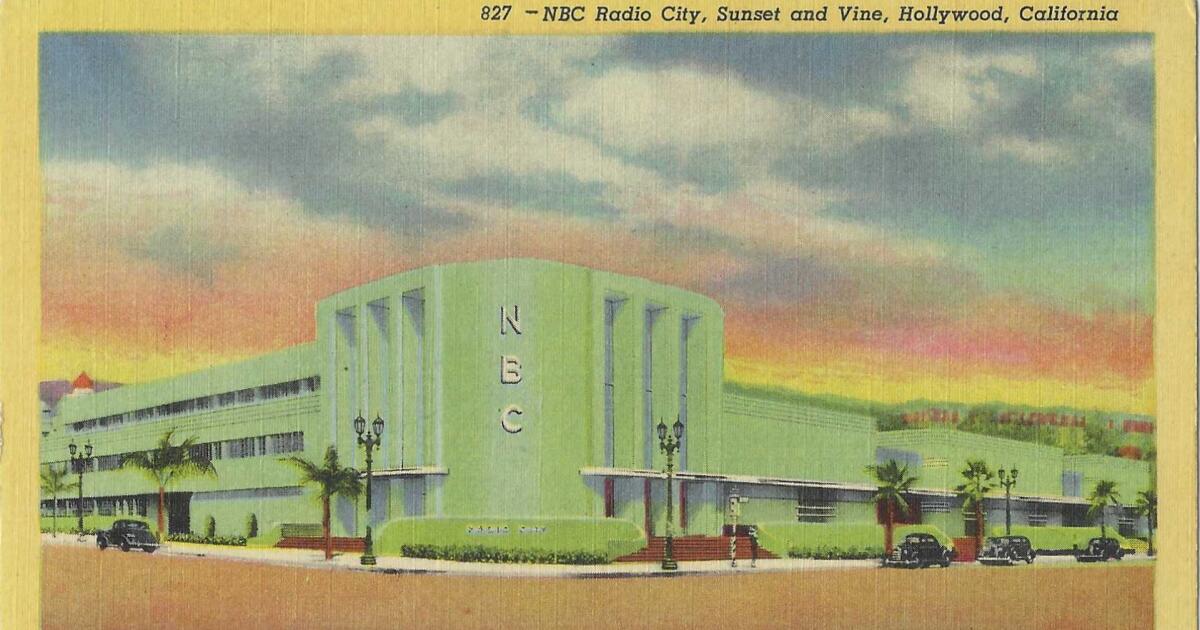Does the alphabet matter in broadcasting any more?
People fire up their phones or tablets, and the way they leap in and out of video and audio, they probably couldn’t tell you which channel’s reports they’d just watched or heard.
Channel? What’s that?
Newsletter
Get the latest from Patt Morrison
Los Angeles is a complex place. Luckily, there’s someone who can provide context, history and culture.
You may occasionally receive promotional content from the Los Angeles Times.
The radio and TV stations whence come the music and the news could get even more anonymized: Many cars are coming off the assembly line missing that democratizing medium of the 20th century, AM radio. (Looking at you, Ford and Tesla, and the rest of the Radio Free Detroit et al. pack.)
If the web makes it easy to uncouple sights and sounds from their sources, what will people remember of stations’ four-letter identifiers, those signifiers of pride and place, the call signs?
Radio stations and even TV stations may change their musical or talk or news formats, or their network allegiances, or they may change their hometowns altogether. But federal regulations insist that they always identify themselves at the beginning of each hour by their call letters and the “city of license.”
This call letter business got codified in 1912, at a “radiotelegraph” conference in London not long after RMS Titanic sank, so the power of wireless communication was very much on delegates’ minds.
The conference handed out call-letter prefixes — C for Canada, X for Mexico, F for France, and so on. The U.S. got K and W, along with two military designations: N for Navy, A for Army and eventually aviation services; K west of the Mississippi, W east, some exceptions.
And soon, the rush was on. (Some early amateur ham radio operators had already been putting material on the air. In 1908, students at L.A.’s Polytechnic High School under the instruction of the magnificently named Professor H. LaV. Twining were building and experimenting with wireless equipment and transmissions. That February, The Times witnessed a student electrical exhibition in a campus basement. The class had cobbled together a homemade Tesla coil, and wireless messages were sent from the basement to the school auditorium by students who, The Times adjudged, could “handle juice most familiarly.”)
The alphabet became the stations’ playground.
The KFWB Hollywood studio, not named for owner Warner Brothers, is seen here on a postcard from Morrison’s collection.
Some got lucky: L.A.’s KFWB radio, now a Mexican regional music station, and for many years one of the region’s two news station, began transmitting 99 years ago. It was co-founded by one of the Warner Brothers, whose studios opened here in 1923. The WB in the call letters led people to conclude it was a deliberate “get” for Warner Brothers, but it was the luck of the draw. KFWA had just been assigned, and KFWC got handed out right afterwards.
Some did get what they wanted. Cowboy singing star and businessman Gene Autry landed the call letters KOOL for his TV station in Phoenix, and KOLD in Tucson. KOLD is still on the air in Tucson; KOOL now appears to be operating as radio-only, in Nebraska and, fittingly, in Alaska.
KGUN, another Tucson station, was originally KDWI, but the man who bought it, H.U. Garrett, was a Texas gun collector and lover of all things Western, and had the call letters changed to KGUN in 1957.
Garrett bought the station from a lumber man named D.W. Ingram, who had used his own monogram as the call letters. As the local legend goes, Garrett changed the call letters to KGUN in part because he loved old guns, and in part because he thought KDWI would make listeners think of drunk driving. The fact that, according to Merriam-Webster, DWI had only entered the vocabulary in 1950 makes this enticing story sound a leeeetle far-fetched.
On a local Tucson news site, right after the Parkland, Fla., school massacre in 2018, a writer argued for changing the name of the station, but it broadcasts as KGUN to this day.
L.A.’s earliest radio stations included KNX, KFI, and KHJ. In April 1922, The Times began broadcasting as KHJ from the rooftop of The Times’ building downtown, “the first newspaper in Southern California to arrange for the establishment of a powerful radio station.”
That first broadcast included “vocal and instrumental music of the highest caliber obtainable” — those being moments from the opera “Tannhauser” — followed by “brief talks by notable men, a bedtime story by one of America’s greatest poet-humorists, and the latest news in bulletin form.”
People with radios hosted “listening parties” all over the place, from the Chamber of Commerce to a campground up in the Arroyo Seco. “Your singer was so popular in this household,” wrote Miss Jean Califf of Pasadena, “that even the cook forgot all about luncheon and burned the muffins.”
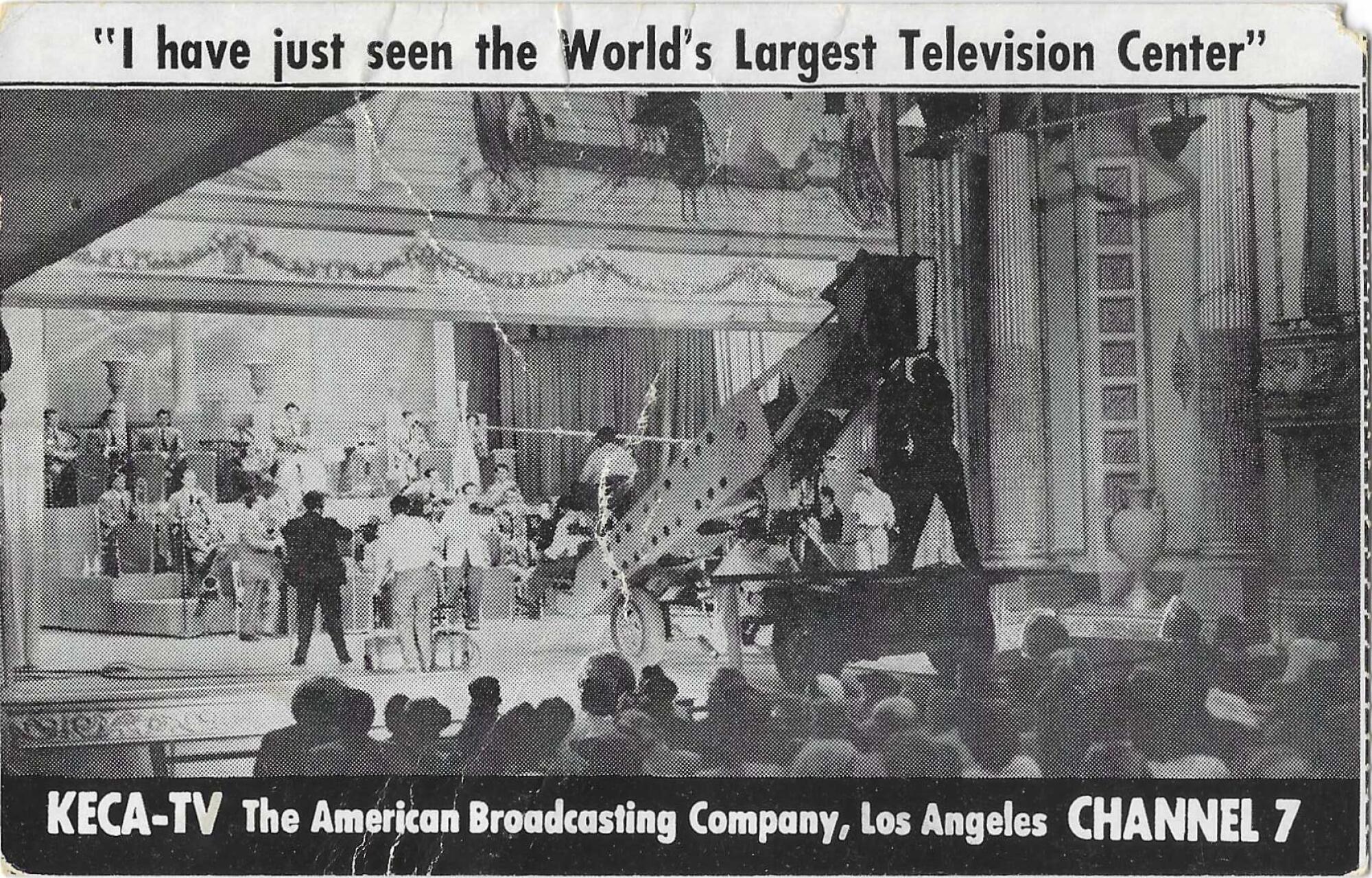
The KECA-TV studio on a vintage postcard from Patt Morrison’s collection. Before ABC ran KECA as a TV station, the KECA radio station was owned, from 1929 to 1944, by Earle C. Anthony (hence ECA), an only-in-L.A. character. Anthony built an early electric car (top speed 6 mph), owned a Packard dealership downtown (7th and Flower) and started KFI-FM (now defunct). Anthony was also an original “doxxer,” announcing the names and home phone numbers of L.A. City Council members on the radio when he thought they were dragging their feet to get the Dodgers here.
In 1947, The Times’ parent company acquired KTTV — call letters for K-Times-Tele-Vision — television; it sold its interest in 1963, when cross-ownership rules frowned on a newspaper owning a TV station in the same market. Paradoxically, more than 50 years later, the Tribune Co. was allowed to own both the Los Angeles Times and KTLA.
Trying to track the evolving call letters and owners and locations of TV and radio stations is like trying to figure out the family trees of royal dynasties of Europe: if you’re not already crazy enough to try, you’ll certainly be driven mad by the time you finish. Also like royal dynasties, some call letter stations just seem to die out.
KTLA — with its happy acronym for television-Los-Angeles — went on the air in January 1947. Just over two years later, it established itself as L.A.’s premier hometown station, and a news pioneer: For something like two days, it broadcast live from a field in San Marino, where all manner of workers were trying to rescue a 3-year-old girl named Kathy Fiscus from the uncapped well she had fallen into. Kathy died, but live, on-the-scene TV news was, in essence, born.
So: In the metastasizing 3-D multiverse of media, where just about anyone with smartphone proficiency can create a personal video channel, will these legacy letters even register with most of the people most of the time?
1

2
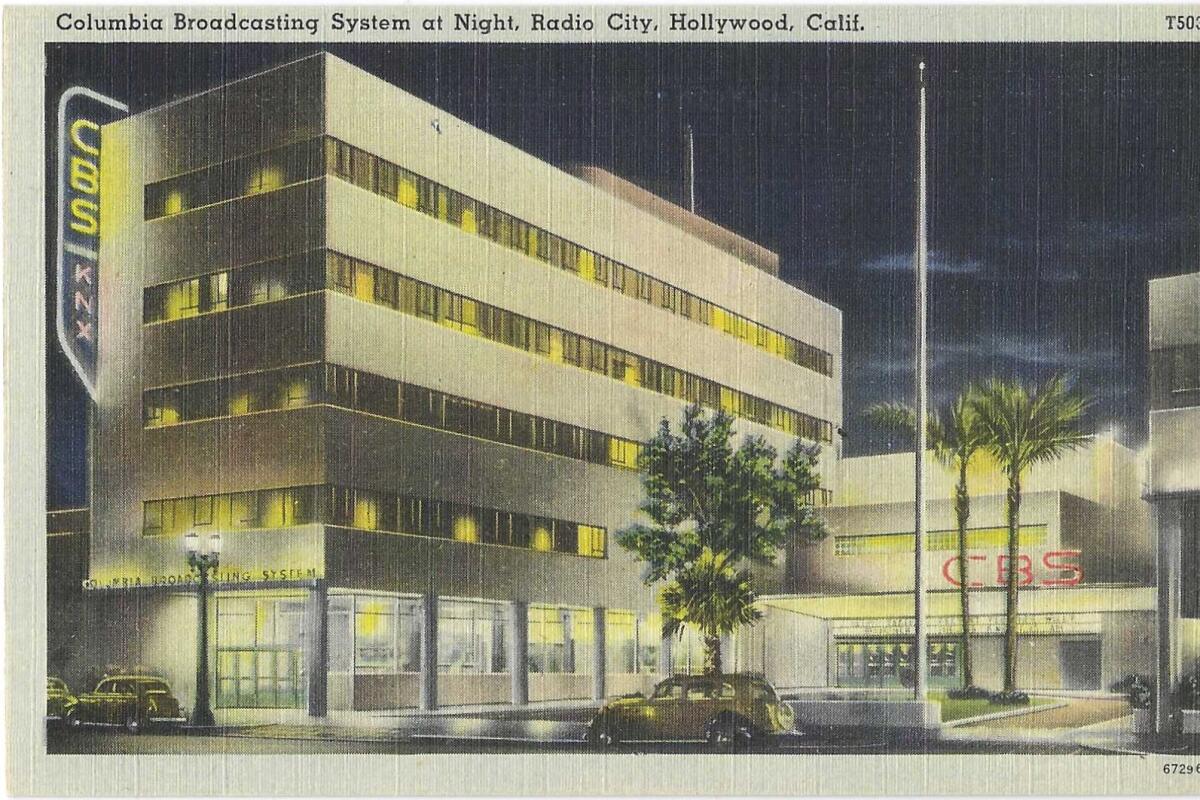
1. A vintage postcard from Patt Morrison’s collection shows Columbia Square, once home to KCBS and KNX. Today the complex in the 6100 block of Sunset Boulevard is the Hollywood location of a members-only workspace and a sushi restaurant, among other businesses. Doubt they served sashimi at the Radio Center Restaurant. 2. And the nighttime view, on another of Morrison’s postcards.
Craig Curtis is a radio consultant, and was the program director at KPCC — now called LAist — when I hosted a two-hour talk program there. A good person to ask.
“Call letters have always and only been simply a random set of letters with no essential meaning to listeners,” he said, “other than the brand value that grows as a station establishes itself and its format in the market, and works hard to use the call letters everywhere possible.”
One example he offers is KHJ, once the L.A. Times radio station, and now, more than a century later, an affiliate of a Catholic radio network. It had a lively variety of incarnations in between.
“For Angelenos of a certain age,” said Curtis, “it meant ‘Boss Radio,’ one of the most important pop music stations in the country in the ’60s and ’70s.”
In the same fashion, KPCC radio, licensed to Pasadena City College — PCC — but broadcasting across the region, “became an important news brand, not because ‘KPCC’ itself means anything, but because KPCC became associated with NPR and local news.”
When radio stations expanded into television, some tacked on “-TV” to their call letters, or just added a “T.” That’s what KNX did when it added television to the radio brand KNX, and voila, KNXT, a leading station here from 1951 until it changed its call letters to KCBS-TV in 1984.
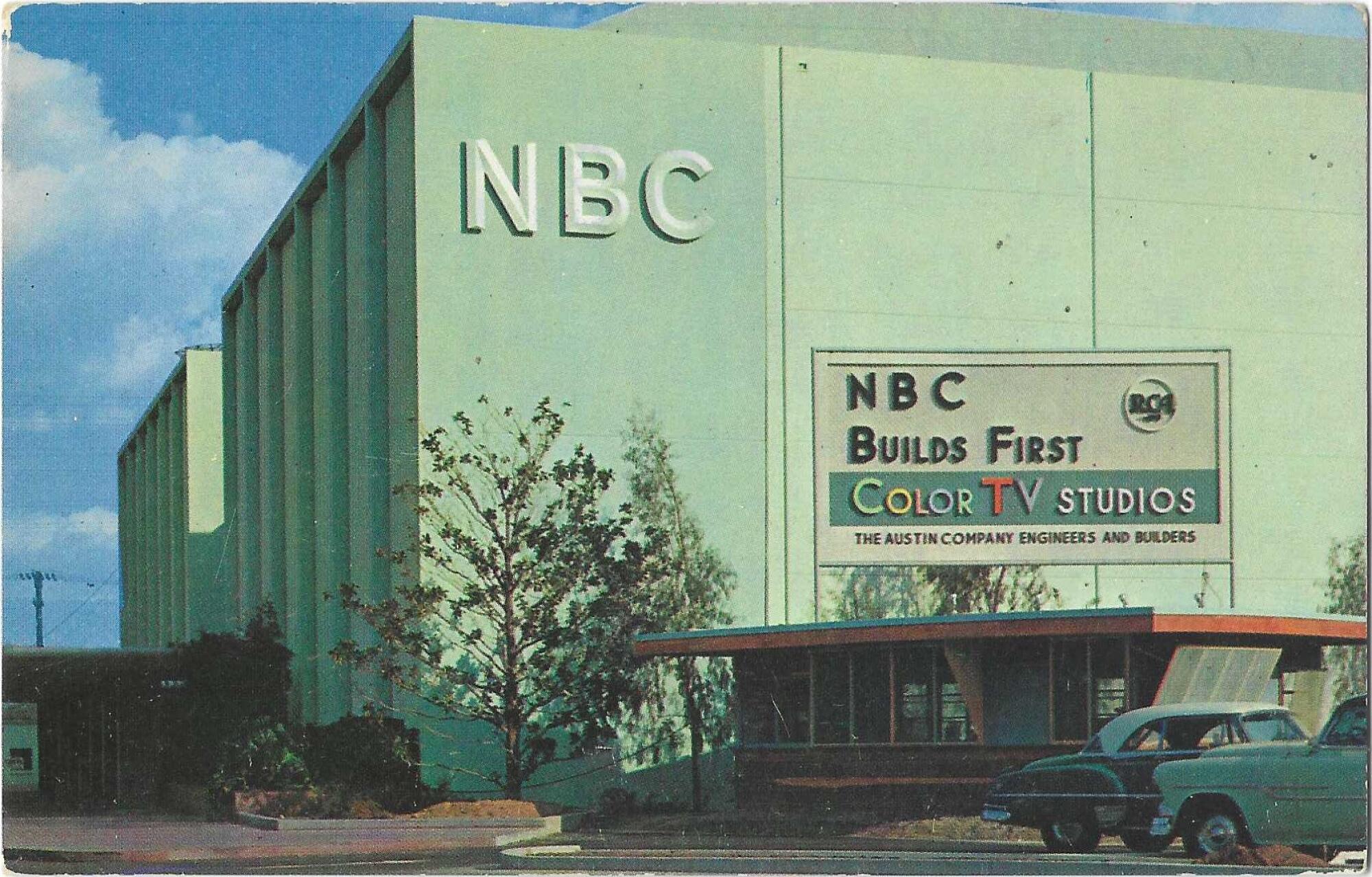
The reverse of this vintage postcard from Patt Morrison’s collection says NBC’s Burbank hub was the “first color television studio in the United States.”
My book-group friend Kelly Lange, a pioneering woman nightly news anchor on Los Angeles television, spent much of her career at the NBC network’s owned-and-operated affiliate here, KNBC.
She recalled that at KNBC — as evidently also happened at the L.A. O-and-O stations KNXT/KCBS-TV as well as KABC-TV — “we were told by New York that we would no longer bother with the K designation, and would refer to ourselves as NBC-4. … Using just the NBC moniker was simply more powerful.”
So that’s why you see ads for NBC4 Southern California, ABC7 Los Angeles, and CBS2 Los Angeles, rather than their full (and more local-sounding) call letters.
Because radio call letters fired up more than 100 years ago, some of them bear the quaint hallmarks of a new medium in that older age.
Call signs for most stations east of the Mississippi River begin with a W, and for stations west of the Mississippi, a K. Beyond that, the imagination ran riot.
Atlanta’s two newspapers hustled to become the first to broadcast radio programs, and about a month before The Times went on the air with KHJ, the Atlanta Journal sent up a radio transmission on WSB. As many stations tried to do, this one came up with a call-letter origin myth, that WSB stood for “Welcome South, Brother.”
The call letters for WHYY, the PBS TV and NPR radio stations broadcasting from Philadelphia, stand, ambitiously, for “Wider Horizons for You and Yours.”
In Chester, S.C., the radio call letters’ acronym, WGCD, represented “Wonderful Guernsey Center of Dixie,” for the caramel-and-white-colored Guernsey cows cultivated by the local radio pioneer’s father.
For KAGH radio in Arkansas, the acronym was wrought into “Keep Arkansas Green Home.” Miami’s WIOD became “Wonderful Isle of Dreams,” and in Kentucky, WMTC meant “Winning Men To Christ,” later broadened to “Winning Many To Christ.”
In 1950 or early 1951, an ambitious broadcaster supposedly wrote to President Harry S Truman for the go-ahead to use the initials HST for his radio station, But after Truman controversially fired Gen. Douglas MacArthur as military commander in Korea, in April 1951, the would-be broadcaster bailed on HST.
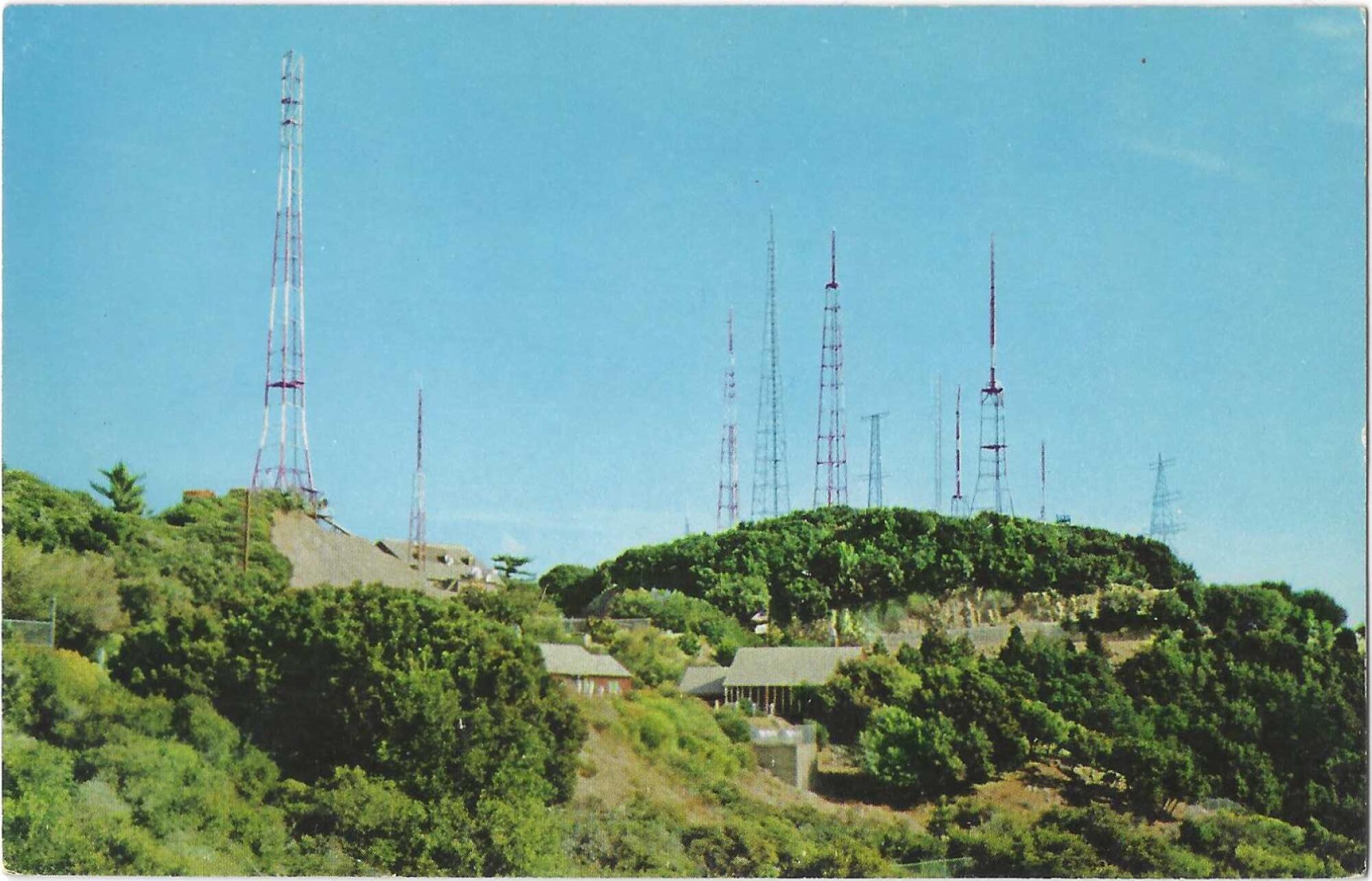
Broadcast towers on Mt. Wilson on a vintage postcard from Patt Morrison’s collection. The reverse of the postcard misidentifies the San Gabriel Mountains and reads: “On the summit of Mt. Wilson, in the Sierra Madre Mountains, 6,000 feet above sea level, are the tall television towers for the various networks in Southern California. From this ideal vantage point, programs are transmitted to all parts of the country.”
I also besought Michael Harrison for his insights. He publishes Talkers, a magazine for and about the talk media business, and he thinks a lot about radio broadcasting’s challenge to refresh its relevance “before the world forgets there was once a thing called radio, and it came out of a cool place known as a radio station.”
Radio stations “still utilize call letters, dial positions or some type of slogan to identify their brand.” But “what they call themselves is not the key issue. It’s what they do between station identifications.
“The job of program director has largely been corporatized in many places to brand manager. The problem they face is radio is no longer one of relatively few places where people can get their news, talk and music. These products are now available on multiple utilitarian platforms in a rapidly expanding digital universe. Radio, once a universe unto itself, is becoming just one button on an even larger media dial.”
Call signs can still have value, as far as Curtis is concerned, “though less so now than when traditional broadcasting reigned. … And there’s no reason call letters can’t be used to also brand digital or any kind of content, which lots of well-known companies do. ESPN is a good example. Hardly anybody knows what ESPN originally stood for (‘Entertainment and Sports Programming Network’), any more than people know what IBM stood for.”
Los Angeles is so vast that it embraces several low-power community stations, KCLA in San Pedro, KQBH, run by the Boyle Heights Arts Conservancy, and KLBP in Long Beach among them.
And in the late 1990s, for a few, a very few, glorious years, KBLT broadcast its pirate programs from Sue Carpenter’s house in Silver Lake. She’d done the same thing in San Francisco with KPBJ, both call signs honoring sandwiches.
She got busted by the FCC, handed over her $500 or so worth of equipment in lieu of a $10,000 fine, and went to work writing about motorcycles and sundry adventures for the L.A. Times, then for the Orange County Register, and wound up back on the radio, talking about modern mobility — for LAist (89.9 on your FM dial).
